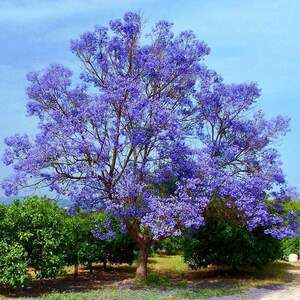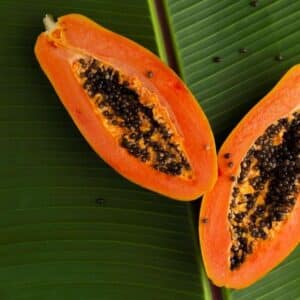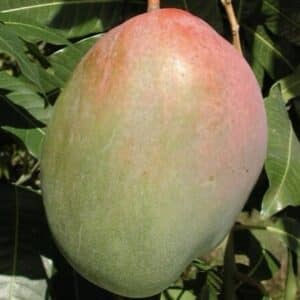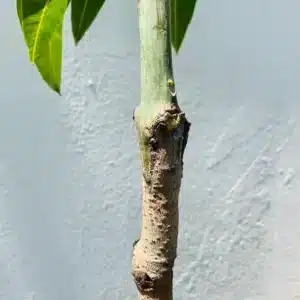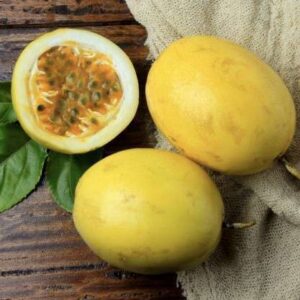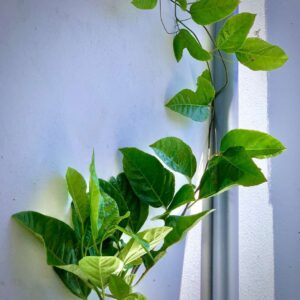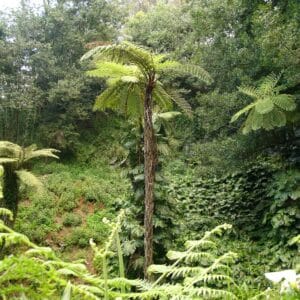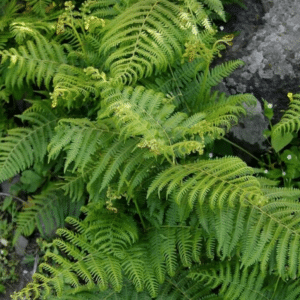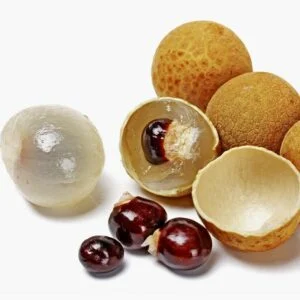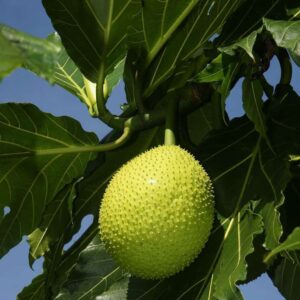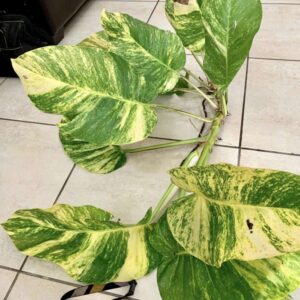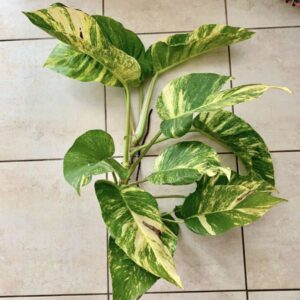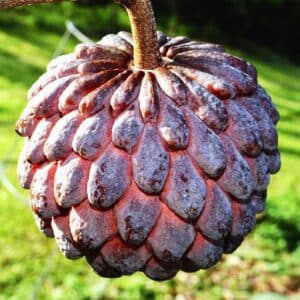Spanish lime (Melicoccus bijugatu) tropical fruit tree
Spanish Lime: The Exotic Fruit with a Tangy Twist
Spanish lime, scientifically known as Melicoccus bijugatus, is a unique and exotic fruit that originates from tropical regions of the Americas, particularly in the Caribbean and parts of South America. Also commonly referred to as "Quenepa," "Mamoncillo," or "Genip," this fruit is known for its distinctive taste, which combines sweetness with a hint of tartness. In this guide, we'll explore the world of Spanish lime, including its taste, cultural significance, culinary uses, and an intriguing fact that adds to its allure.
Big Jacaranda blue tree (jacaranda mimosifolia) tropical exotic tree 2’-3’ feet tall
One of the world’s brightest trees! Spring and summer is the season for the most jacaranda show of blue purple flowers you will ever see on a large tropical tree. It’s almost as if the tree is glowing with lights due to the bright vivid color of the blooms.
Jacaranda trees, also known as Jacaranda mimosifolia, are a species of flowering tree native to South America but are now commonly grown in tropical and subtropical regions around the world. Jacaranda trees are known for their beautiful lavender-blue flowers that bloom in the spring and summer, which have earned them the nickname "purple trumpet tree". In this description, we will discuss how to plant and care for Jacaranda trees, and some of the benefits they can provide.
An interesting fact about Jacaranda trees is that they are a popular symbol of spring in many parts of the world. In some cities, such as Pretoria, South Africa and Grafton, Australia, entire streets are lined with Jacaranda trees that bloom in the spring and create a stunning display of purple flowers. In addition to their beauty, Jacaranda trees also have cultural significance in many parts of the world. In Argentina, for example, it is believed that if a Jacaranda flower falls on your head, you will have good luck. In Brazil, the Jacaranda tree is the national tree, and its wood is used to make musical instruments such as guitars and violins. The Jacaranda tree is not only beautiful but also has cultural and symbolic significance in many parts of the world.
Mango tree (mangifera) live fruit tree 12″- 24″ tall
Yellow Mango : Nature's Sweet Miniature Delights
Imagine plucking tiny, sun-kissed mangoes from a compact tree in your garden, their vibrant yellow hue promising a burst of sweet, tropical flavor with every bite. This delightful vision can be a reality with the enchanting yellow small mango variety. These miniature mangoes are not only a visual delight but also a delectable treat for your taste buds. In this online sale, we introduce you to the world of yellow small mangoes, from planting and care to their charming characteristics and culinary uses.
When you purchase a fruit tree from us, rest assured that we prioritize swift and efficient delivery. Following the receipt of your payment, we dispatch your tree the very next day through USPS, ensuring a quick transition from our care to yours. Our fruit trees are not only certified by the USDA, guaranteeing their quality and adherence to stringent agricultural standards, but they also come with a 30-day guarantee. Should you encounter any issues within this period, please don't hesitate to contact us at the number provided above. For a faster resolution, we recommend sending pictures or explaining the situation with your order number. This allows us to understand the issue fully and take the necessary steps to make things right for you.
Papaya (Carica papaya) live fruit tree 1’-2’
Papaya: The Tropical Marvel with Health Benefits
Papaya, scientifically known as Carica papaya, is a vibrant and tropical fruit cherished not only for its sweet, succulent taste but also for its numerous health benefits. In this comprehensive guide, we'll delve into the world of papayas, exploring their taste, nutritional value, culinary uses, cultivation tips, and an intriguing fact that will deepen your appreciation for this tropical marvel.
Grafted Mango Keitt (mangifera) live fruit tree 3’-4’ feet tall
The grafted Keitt mango tree is a premium tropical fruit tree known for its large, sweet, and juicy mangoes with a nearly fiberless texture. Originally developed in Florida, the Keitt mango is highly valued for its extended fruiting season, late harvest, and excellent shelf life. Grafted Keitt mango trees offer early fruiting, consistent quality, and a high-yield harvest, making them an excellent choice for home gardens, orchards, and tropical landscapes.
Passion fruit live fruit plant 1’-2’
Passion Fruit: A Tropical Delight for Your Garden and Palate
Passion fruit, scientifically known as Passiflora edulis, is a captivating and exotic fruit that not only adds a touch of tropical elegance to your garden but also tantalizes your taste buds with its unique flavor. In this guide, we'll delve into the fascinating world of passion fruit, offering insights into its cultivation, care, culinary uses, and a delightful fact that will make you appreciate it even more.
Grafted Mango Julie (mangifera indica) live fruit tree 3′-4 feet’
The Grafted Mango Tree, specifically the Julie variety, is a delightful addition to any garden or landscape. This meticulously grafted tree stands at a convenient height of 3 feet, making it a versatile choice for both small and large spaces. The Julie mango variety, celebrated for its exquisite flavor, is often hailed as the "Caribbean's best mango." It offers a sweet and aromatic taste with hints of citrus and spice, making it a favorite among mango enthusiasts and a must-have addition to your garden.
An interesting fact about Julie mangoes, the variety featured in this grafted mango tree, is that they are often referred to as the "king of mangoes" in the Caribbean. The nickname "Julie" is believed to have originated from the French word "joli," which means pretty or attractive. It perfectly captures the essence of these mangoes, known for their petite size and stunningly delicious flavor. Julie mangoes have also been called "the butter of mangoes" due to their smooth, creamy texture and rich, sweet taste, making them a prized delicacy in the tropical regions where they are grown.
Breadfruit (Artocarpus camansi ) tropical live fruit tree 1′-2′ feet
Artocarpus camansi, commonly known as breadnut or seeded breadfruit, is a tropical tree belonging to the Moraceae family. It is a medium to large-sized tree with a straight trunk and a spreading crown. The leaves are large, glossy, and deeply lobed, adding to its aesthetic appeal. The highlight of this tree is its fruits, which resemble breadfruit but are smaller and have a spiky exterior. Each fruit contains multiple seeds embedded in a creamy, edible pulp.
Artocarpus camansi is native to Southeast Asia and is widely cultivated in the Philippines and other tropical regions. The fruits are consumed when ripe and have a starchy and nutty flavor. They can be boiled, roasted, or used in various culinary preparations. The seeds, after cooking, are also edible and can be used as a substitute for chestnuts. The wood of the tree is durable and used for construction, furniture, and carving.
This tree thrives in tropical and subtropical climates, preferring full sun exposure and well-drained soil. It is relatively low-maintenance and can tolerate some drought once established. Artocarpus camansi is valued for its fast growth and its ability to provide food and other resources in agroforestry systems. Its attractive appearance and delicious fruits make it a popular choice among gardeners and fruit enthusiasts.
Red Sugar apple (Annona squamosa ) Vibrant live fruit tree 12”-24” Thriving
Revealing the Red Sugar Apple Tree: An Orchard of Exquisite Delight
Enter a world where sweetness is painted in hues of red and green, where the air carries the aroma of delectable treats waiting to be savored. The Red Sugar Apple Tree (*Annona squamosa*), an embodiment of natural indulgence, invites you to discover the joy of growing your own luscious fruits and relishing the harmonious blend of flavor and fragrance.



